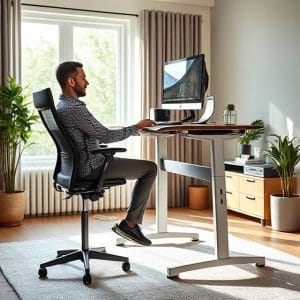Ergonomic Office Setup for Tall Workers: What Actually Works

If you’re tall and spend hours working at a desk, you probably know this pain: sore neck, cramped legs, aching back, and a chair that feels like it was designed for a toddler. That’s not just uncomfortable—it’s a recipe for long-term health problems.
But don’t worry. In this guide, you’ll learn how to create an ergonomic office setup that fits your tall frame. Because you deserve comfort too.
Why Most Office Furniture Doesn’t Work for Tall People
Standard office equipment is made for the “average” height—which usually means someone between 5’5″ and 5’10”. If you’re taller than 6 feet, you’re likely dealing with:
Low desks that force you to hunch
Short chairs that don’t support your legs
Monitors placed too low for your eye level
Lack of legroom underneath desks
All of this leads to poor posture, back and neck pain, and lower productivity.
Must-Have Ergonomic Gear for Tall Professionals
Let’s break down the essentials for your workspace.
1. Adjustable Sit-Stand Desk
Look for desks that extend to at least 50 inches high.
Gives you room to stand comfortably or sit without crunching.
Best options:
UPLIFT V2 Standing Desk
Fully Jarvis Bamboo Desk (tall frame version)
2. Tall-Friendly Office Chair
Key features: high seat height (20”+), deep seat pan, adjustable armrests.
Look for chairs with adjustable lumbar support and seat depth.
Top picks:
Steelcase Leap Plus
Herman Miller Aeron (Size C)
3. Monitor Riser or Adjustable Arm
Raise your screen so your eyes are level with the top third of your monitor.
Helps prevent neck strain and forward-leaning posture.
4. Under-Desk Footrest (Optional)
For times when you sit higher, a footrest can reduce pressure on your thighs.
5. Extended Keyboard Tray
Keeps your elbows at a 90-degree angle while typing, no matter your height.
Tips to Maximize Comfort All Day Long
Stand and stretch every 30–60 minutes. Tall bodies need more circulation.
Position screens directly in front of you to avoid twisting your spine.
Keep wrists neutral by adjusting keyboard and mouse height.
Don’t slouch—even if it feels natural in tiny chairs!
Budget-Friendly Solutions (No Full Office Makeover Needed)
If you’re not ready to buy new furniture just yet, here’s how you can adapt what you already have:
Use bed risers or blocks to lift your desk.
Add a seat cushion to increase chair height.
Prop your monitor on books or boxes.
DIY a footrest from foam or wood.
Even small tweaks can make a big difference in your daily comfort.
Key Takeaways
Standard office furniture is not built for you, and that’s okay—you have options.
Invest in a high desk and tall-friendly chair to prevent chronic pain.
Make simple adjustments to your current setup if you’re on a budget.
Your comfort affects your productivity and your long-term health.
FAQ
Q: What’s the ideal desk height for someone over 6 feet?
A: Generally, between 29″ and 33″ depending on your exact height and whether you’re sitting or standing.
Q: Can I make a standard desk work for my height?
A: Yes! Use risers, cushions, and monitor arms to customize your setup without replacing everything.
Q: Should tall people avoid sit-stand desks?
A: Not at all! In fact, they’re ideal—just make sure the model goes high enough for your standing height.
Final Word
Working in discomfort is not something you have to “just deal with.” You can build a tall-friendly, ergonomic office setup that actually works for your body—and helps you thrive professionally and physically.






